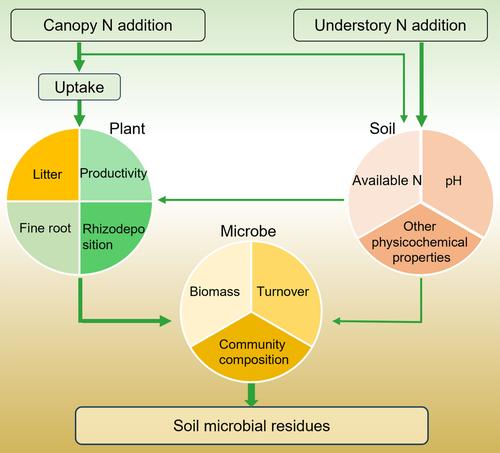当前位置:
X-MOL 学术
›
Glob. Change Biol.
›
论文详情
Our official English website, www.x-mol.net, welcomes your
feedback! (Note: you will need to create a separate account there.)
Canopy and understory nitrogen additions differently affect soil microbial residual carbon in a temperate forest
Global Change Biology ( IF 10.8 ) Pub Date : 2024-07-18 , DOI: 10.1111/gcb.17427 Yuanqi Chen 1, 2 , Yu Zhang 3 , Xu Zhang 3 , Carly Stevens 4 , Shenglei Fu 5 , Teng Feng 1 , Xiaowei Li 5 , Quan Chen 6 , Shirong Liu 2 , Shuijin Hu 7
Global Change Biology ( IF 10.8 ) Pub Date : 2024-07-18 , DOI: 10.1111/gcb.17427 Yuanqi Chen 1, 2 , Yu Zhang 3 , Xu Zhang 3 , Carly Stevens 4 , Shenglei Fu 5 , Teng Feng 1 , Xiaowei Li 5 , Quan Chen 6 , Shirong Liu 2 , Shuijin Hu 7
Affiliation

|
Atmospheric nitrogen (N) deposition in forests can affect soil microbial growth and turnover directly through increasing N availability and indirectly through altering plant‐derived carbon (C) availability for microbes. This impacts microbial residues (i.e., amino sugars), a major component of soil organic carbon (SOC). Previous studies in forests have so far focused on the impact of understory N addition on microbes and microbial residues, but the effect of N deposition through plant canopy, the major pathway of N deposition in nature, has not been explicitly explored. In this study, we investigated whether and how the quantities (25 and 50 kg N ha−1 year−1 ) and modes (canopy and understory) of N addition affect soil microbial residues in a temperate broadleaf forest under 10‐year N additions. Our results showed that N addition enhanced the concentrations of soil amino sugars and microbial residual C (MRC) but not their relative contributions to SOC, and this effect on amino sugars and MRC was closely related to the quantities and modes of N addition. In the topsoil, high‐N addition significantly increased the concentrations of amino sugars and MRC, regardless of the N addition mode. In the subsoil, only canopy N addition positively affected amino sugars and MRC, implying that the indirect pathway via plants plays a more important role. Neither canopy nor understory N addition significantly affected soil microbial biomass (as represented by phospholipid fatty acids), community composition and activity, suggesting that enhanced microbial residues under N deposition likely stem from increased microbial turnover. These findings indicate that understory N addition may underestimate the impact of N deposition on microbial residues and SOC, highlighting that the processes of canopy N uptake and plant‐derived C availability to microbes should be taken into consideration when predicting the impact of N deposition on the C sequestration in temperate forests.
中文翻译:

冠层和林下氮添加对温带森林土壤微生物残留碳的影响不同
森林中的大气氮(N)沉降可以通过增加氮的有效性直接影响土壤微生物的生长和周转,并通过改变微生物对植物来源的碳(C)的有效性间接影响土壤微生物的生长和周转。这会影响微生物残留物(即氨基糖),而微生物残留物是土壤有机碳(SOC)的主要组成部分。迄今为止,森林研究主要集中在林下氮添加对微生物和微生物残留的影响,但尚未明确探索植物冠层氮沉降的影响,而植物冠层是自然界氮沉降的主要途径。在本研究中,我们调查了数量(25 公斤和 50 公斤氮·公顷)是否以及如何−1年−1 )和氮添加模式(林冠和林下)会影响温带阔叶林十年氮添加下的土壤微生物残留。我们的结果表明,施氮提高了土壤氨基糖和微生物残留碳(MRC)的浓度,但没有提高它们对SOC的相对贡献,并且这种对氨基糖和MRC的影响与施氮的数量和方式密切相关。在表土中,无论氮添加模式如何,高氮添加都会显着增加氨基糖和 MRC 的浓度。在底土中,只有冠层氮的添加对氨基糖和 MRC 产生积极影响,这意味着通过植物的间接途径发挥着更重要的作用。冠层和林下氮的添加均不会显着影响土壤微生物生物量(以磷脂脂肪酸为代表)、群落组成和活性,这表明氮沉降下微生物残留量的增加可能源于微生物周转的增加。 这些发现表明,林下氮添加可能低估了氮沉降对微生物残留和有机碳的影响,强调在预测氮沉降对微生物残留的影响时,应考虑冠层氮吸收过程和植物来源的碳对微生物的有效性。温带森林中的碳封存。
更新日期:2024-07-18
中文翻译:

冠层和林下氮添加对温带森林土壤微生物残留碳的影响不同
森林中的大气氮(N)沉降可以通过增加氮的有效性直接影响土壤微生物的生长和周转,并通过改变微生物对植物来源的碳(C)的有效性间接影响土壤微生物的生长和周转。这会影响微生物残留物(即氨基糖),而微生物残留物是土壤有机碳(SOC)的主要组成部分。迄今为止,森林研究主要集中在林下氮添加对微生物和微生物残留的影响,但尚未明确探索植物冠层氮沉降的影响,而植物冠层是自然界氮沉降的主要途径。在本研究中,我们调查了数量(25 公斤和 50 公斤氮·公顷)是否以及如何−1年−1 )和氮添加模式(林冠和林下)会影响温带阔叶林十年氮添加下的土壤微生物残留。我们的结果表明,施氮提高了土壤氨基糖和微生物残留碳(MRC)的浓度,但没有提高它们对SOC的相对贡献,并且这种对氨基糖和MRC的影响与施氮的数量和方式密切相关。在表土中,无论氮添加模式如何,高氮添加都会显着增加氨基糖和 MRC 的浓度。在底土中,只有冠层氮的添加对氨基糖和 MRC 产生积极影响,这意味着通过植物的间接途径发挥着更重要的作用。冠层和林下氮的添加均不会显着影响土壤微生物生物量(以磷脂脂肪酸为代表)、群落组成和活性,这表明氮沉降下微生物残留量的增加可能源于微生物周转的增加。 这些发现表明,林下氮添加可能低估了氮沉降对微生物残留和有机碳的影响,强调在预测氮沉降对微生物残留的影响时,应考虑冠层氮吸收过程和植物来源的碳对微生物的有效性。温带森林中的碳封存。











































 京公网安备 11010802027423号
京公网安备 11010802027423号